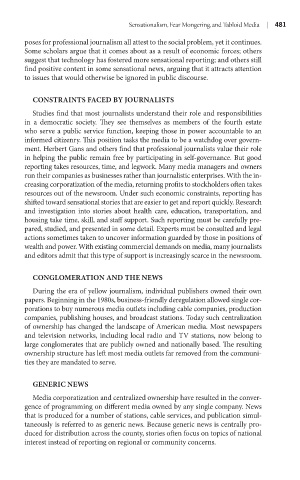Page 502 - Battleground The Media Volume 1 and 2
P. 502
Sensat onal sm, Fear Monger ng, and Tablo d Med a | 1
poses for professional journalism all attest to the social problem, yet it continues.
Some scholars argue that it comes about as a result of economic forces; others
suggest that technology has fostered more sensational reporting; and others still
find positive content in some sensational news, arguing that it attracts attention
to issues that would otherwise be ignored in public discourse.
ConsTrainTs FaCED By JournaLisTs
Studies find that most journalists understand their role and responsibilities
in a democratic society. They see themselves as members of the fourth estate
who serve a public service function, keeping those in power accountable to an
informed citizenry. This position tasks the media to be a watchdog over govern-
ment. Herbert Gans and others find that professional journalists value their role
in helping the public remain free by participating in self-governance. But good
reporting takes resources, time, and legwork. Many media managers and owners
run their companies as businesses rather than journalistic enterprises. With the in-
creasing corporatization of the media, returning profits to stockholders often takes
resources out of the newsroom. Under such economic constraints, reporting has
shifted toward sensational stories that are easier to get and report quickly. Research
and investigation into stories about health care, education, transportation, and
housing take time, skill, and staff support. Such reporting must be carefully pre-
pared, studied, and presented in some detail. Experts must be consulted and legal
actions sometimes taken to uncover information guarded by those in positions of
wealth and power. With existing commercial demands on media, many journalists
and editors admit that this type of support is increasingly scarce in the newsroom.
CongLomEraTion anD ThE nEws
During the era of yellow journalism, individual publishers owned their own
papers. Beginning in the 1980s, business-friendly deregulation allowed single cor-
porations to buy numerous media outlets including cable companies, production
companies, publishing houses, and broadcast stations. Today such centralization
of ownership has changed the landscape of American media. Most newspapers
and television networks, including local radio and TV stations, now belong to
large conglomerates that are publicly owned and nationally based. The resulting
ownership structure has left most media outlets far removed from the communi-
ties they are mandated to serve.
gEnEriC nEws
Media corporatization and centralized ownership have resulted in the conver-
gence of programming on different media owned by any single company. News
that is produced for a number of stations, cable services, and publication simul-
taneously is referred to as generic news. Because generic news is centrally pro-
duced for distribution across the county, stories often focus on topics of national
interest instead of reporting on regional or community concerns.

